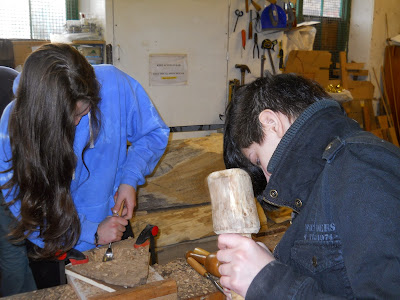Redland chapel is situated in a suburb of Bristol. It was opened in October 1743 and was commissioned by John Cossins as a private chapel for his family.
The chapel is very unusual as it is not dedicated to a particular saint, holy figure or the Christian Trinity. Some have speculated that this may have been largely because it was a private chapel but maybe also because Cossins was a freemason and symbols such as the eye of Osiris were apparently part of the original decoration. When built, it would have stood in a rural setting overlooking small villages, which are now suburbs of the city. These unusual carvings of young African faces look out over the view.
Why such unique subject matter? No one is sure, perhaps it was related to Bristol's unfortunate links to the slave trade, perhaps they were servants who have been immortalised watching over the family tomb below or perhaps it is simply that such portrayals were in vogue at the time.
Inside the chapel are the carvings that I had travelled here to see. Thomas Paty was an eighteenth century carver of stone and wood who was largely based in Bristol, where he worked with his sons John and William. Several local buildings contain sculpture by the Patys. Although the work looks similar to Grinling Gibbons' carving, Thomas Paty was born about eight years before Gibbons died so they were not working at the same time.
 |
| Image from:http://bristolgems.wordpress.com/2012/04/19/a-country-chapel-redland-parish-church/ |
Unfortunately, a large part of the carved work is obscured by an unfortunately-placed projection screen which is apparently prone to jamming when raised. It also covers a large oil painting of the Embalming of Christ by John Vanderbank. The painting is an eighteenth-century copy of an earlier one by Annibale Caracci, which hung in Houghton Hall in Norfolk before going into the collection of the Russian royal family, where it was destroyed in a fire. I only hope that the location of the projection screen can be changed or the jamming sorted out , as it seems like a terrible shame to hide such beautiful and important work behind this blank white obstruction, as you can see below...
It was certainly worth it, they are stunning. The restoration work has not filled in every worm hole, as you can see below, but particularly damaged parts were replaced and everything cleaned, apparently the cleaning material being saliva on cotton buds. I was told that saliva contains enzymes that make it more effective than water for the job.
The cover of the font below was stolen during the break-in and a replacement has been carved and gilded by Laurence Beckford
The 'Bristolgems' blog has some very interesting information about the chapel and about Paty himself.
Near the entrance are two marble busts carved by the noted carver John Michael Rysbrack, who was originally Flemish but based himself in London and was one of the pre-eminent portrait sculptors of the time. They depict John and William Innys, the brothers of John Cossins' wife Martha, in informal attire. Perhaps this was also the fashion during that period?
The informality does seem a bit odd in a church, especially when the nearby busts of John and Martha Cossins (also by Rysbrack) are much more formal.
The busts of the Cossins were made in 1734 and kept at their house until Martha's death in 1762. If the busts of her brothers were made at the same time and kept in the house, that could possibly explain their informality. Maybe Cossins and Martha preferred a more formal look?
Unfortunately, following the break-in the chapel now has to be locked outside of times of services. However, if you contact the chapel, they are happy to show people inside by appointment. Many thanks to Gill and Michael for taking time to show me around and chat about the beautiful work there.

















































